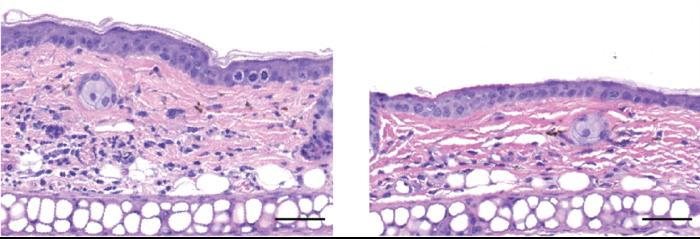SYM2081 inhibits inflammation-driving mast cells in mouse models and human skin samples, paving the way for new topical treatments to prevent itching, hives, and other symptoms of skin conditions driven by mast cells, finds a study published in Science Translational Medicine.
“I’m really excited about the clinical possibilities of this research,” says senior author Daniel Kaplan, MD, PhD, Professor of Dermatology and Immunology at the University of Pittsburgh in Pittsburgh, PA, in a news release. “Currently, there aren’t a lot of good therapies that target mast cells, so we think that our approach could potentially have huge benefits in many skin conditions, including rosacea, eczema, urticaria and mastocytosis.”
In a previous Cell paper, Dr. Kaplan and his team found that neurons in the skin release a neurotransmitter called glutamate that suppresses mast cells. When they deleted these neurons or inhibited the receptor that recognizes glutamate, mast cells became hyperactive, leading to more inflammation.
“This finding led us to wonder if doing the opposite would have a beneficial effect,” says Dr. Kaplan. “If we activate the glutamate receptor, maybe we can suppress mast cell activity and inflammation.”
To test this hypothesis, lead author Youran Zhang, a medical student at Tsinghua University in Beijing, China who did this research as a visiting scholar in Kaplan’s lab, and Tina Sumpter, PhD, a research assistant professor in the Pitt Department of Dermatology, looked at a compound called SYM2081, or 4-methylglutamate, that activates a glutamate receptor called GluK2 found almost exclusively on mast cells.
They found that SYM2081 effectively suppressed mast cell degranulation and proliferation in both mice and human skin samples. And when the mice received a topical cream containing SYM2081 before the induction of rosacea- or eczema-like symptoms, skin inflammation and other symptoms of disease were much milder.
According to Dr. Kaplan, these findings suggest that suppressing mast cells with a daily cream containing a GluK2-activating compound could be a promising way to prevent rosacea and other inflammatory skin conditions.
“Although there are excellent therapies available for different types of rosacea, many are antibiotic-based and they only target some of the symptoms,” says Dr. Kaplan. “There are no good therapies for flushing, so this is a significant unmet need. Our study suggests that suppressing mast cells by activating GluK2 could reduce the flushing associated with rosacea.”
Now that the researchers have demonstrated proof-of-concept of their approach, they hope to engineer new GluK2-activating compounds that could eventually be tested in clinical trials. Through the Pitt Office of Innovation and Entrepreneurship’s Innovation Institute, they have also applied for a patent for the use of SYM2081 to suppress mast cell function.
IMAGE CAPTION: In a mouse model of contact dermatitis, preventive application of a cream containing SYM2081 (right image) reduced skin swelling compared to placebo (left image).
IMAGE CREDIT: Youran Zhang


